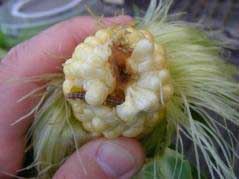|
Remember The European Corn Borer?
URBANA, ILL.
The European corn borer, once regarded as a major and consistent
insect pest, is now only rarely observed in most commercial cornfields
across the Corn Belt, said a University of Illinois entomologist.
Mike Gray said that in 1939, European corn borers were first reported
in Illinois and by 1942 the pest could be found in all counties within
the state. “William ‘Bill’ Luckmann, a longtime retired and well-known
entomologist, once mentioned that he had only observed two cornfields
totally destroyed by insects – once by chinch bugs and once by European
corn borers,” Gray said.
Since the introduction of Bt hybrids in 1996, the use of transgenic
corn has risen sharply. Gray said that according to the USDA Economic
Research Service, Bt hybrids were planted on 76 percent of the U.S. corn
acres in 2013. In 2013, transgenic corn hybrids (including Bt hybrids,
stacked hybrids [Bt and herbicide tolerant], and herbicide tolerant
only) were used on 90 percent of corn acres. The widespread use of
highly effective Bt hybrids on lepidopterous insect pests such as the
European corn borer has had a significant area-wide population
suppression effect on this once prominent species.
“In evening drives around the state of Illinois the past few years,
the first or second flights of European corn borers have been barely
noticeable,” Gray said. “Many will recall what these spring and summer
evening drives did to our windshields.”

Depending on the accumulation of heat units, the first flight of
European corn borers generally lasts from mid-May through mid-June.
Moths emerge from corn residue and seek out areas of dense vegetation
found in ditch banks, fence rows, and grass waterways. Gray explained
that females emit a sex pheromone in these “action sites” very late in
the evening that attracts males and mating ensues. Females depart action
sites after sundown and begin laying egg masses in nearby cornfields,
typically two egg masses per night for upwards of 10 days.
From June 13 to 26, a Department of Crop Sciences research team led
by Ron Estes, principal research specialist in agriculture, and Nicholas
Tinsley, postdoctoral research associate, conducted surveys of action
sites in the following 12 counties: Champaign (June 13, 5 action sites),
Clinton (June 24, 3 action sites), Douglas (June 13, 5 action sites),
Fayette (June 24, 4 action sites), Jefferson (June 24, 3 action sites),
Kankakee (June 26, 5 action sites), Kendall (June 26, 5 action sites),
Knox (June 17, 5 action sites), McLean (June 17, 5 action sites), Pike
(June 18, 3 action sites), Sangamon (June 18, 3 action sites), and
Whiteside (June 25, 5 action sites).
Within each action site, 100 sweeps were taken and very few moths (9
total) were collected: Champaign County (1), Douglas County (3 - one in
each of 3 sites), Kankakee County (1), Kendall County (1), Knox County
(1), McLean County (1), and Sangamon County (1). During these surveys,
51 action sites (100 sweeps/site) were sampled across 12 counties
resulting in 5,100 sweeps that yielded 9 moths, or 0.0018 moths per
sweep.
“Based upon these results, I believe the following questions are
worthy of consideration. Are too few survivors emerging from Bt fields
to sustain the continuing efficacy of Bt hybrids against European corn
borers? So far, no field-selected Bt-resistant strains of European corn
borers have been documented,” Gray said.
Gray questioned if the smaller (5 percent) seed-blend refuges will
result in even fewer European corn borer survivors in the landscape and
further increase the selection pressure for resistance development.
“Recall that structured 20-percent refuges were the norm for Bt corn
hybrids for many years. In addition, the structured refuge was a
preferred resistance management approach along with the use of high-dose
Bt hybrids for European corn borers,” he added.
Gray explained that early on, concern over larval movement from plant
to plant by European corn borer larvae resulted in scientists favoring a
structured refuge versus a seed blend for this insect pest. “Is the
added cost of Bt hybrids worth the investment for this insect pest in
light of very low densities of the European corn borer and the less than
favorable current and projected commodity prices?
“If the use of Bt hybrids declined, would producers have sufficient
time to scout large commercial cornfields, utilize economic thresholds,
and apply rescue treatments as needed? Time will tell if this once very
significant insect pest will return as a consistent threat,” he said. ∆
|
|